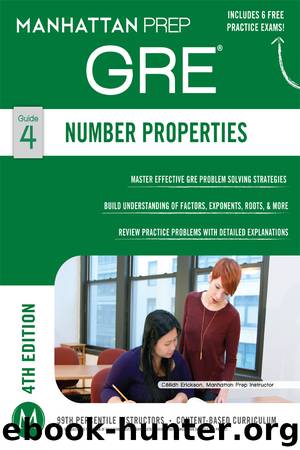Number Properties GRE Strategy Guide by Manhattan Prep

Author:Manhattan Prep
Language: eng
Format: epub
Publisher: MG Prep, Inc.
Chapter 5
of
Number Properties
Exponents
In This Chapter…
Wow, That Increased Exponentially!
All About the Base
All About the Exponent
Combining Exponential Terms
Rewriting Bases
Simplifying Exponential Expressions
Rules of Exponents
Common Exponent Errors
Chapter 5
Exponents
The mathematical expression 43 consists of a base (4) and an exponent (3).
The expression is read as “four to the third power.” The base (4) is multiplied by itself as many times as the power requires (3).
Thus, 43 equals 4 × 4 × 4 = 64.
Two exponents have special names: the exponent 2 is called the square, and the exponent 3 is called the cube. For example, 52 can be read as five to the second power, or as five squared (52 = 5 × 5 = 25); 53 can be read as five to the third power, or as five cubed (53 = 5 × 5 × 5 = 125).
Wow, That Increased Exponentially!
Have you ever heard the expression: “Wow, that increased exponentially!”? This phrase captures the essence of exponents. When a positive number greater than 1 increases exponentially, it does not merely increase; it increases a whole lot in a short amount of time.
An important property of exponents is that the greater the exponent, the faster the rate of increase. Consider the following progression:
51 = 5
52 = 25 Increased by 20
53 = 125 Increased by 100
54 = 625 Increased by 500
The important thing to remember is that for positive bases bigger than 1, the greater the exponent, the faster the rate of increase.
All About the Base
The Sign of the Base
The base of an exponential expression may be either positive or negative. With a negative base, simply multiply the negative number as many times as the exponent requires.
For example:
(−4)2 = (−4) × (−4) = 16 (−4)3 = (−4) × (−4) × (−4) = −64
Consider this problem:
If x2 = 16, is x equal to 4?
Your initial inclination is probably to say yes. However, x may not be 4; it may be −4. Thus, you cannot answer the question without additional information. You must be told that x is positive in order to affirm that x is 4. Beware whenever you see an even exponent on the test. Another important thing to remember is that according to the Order of Operations rules, (PEMDAS), exponents have higher precedence than subtraction, so −42 means −(42) = −16, not (−4)2 = 16.
The Even Exponent Is Dangerous: It Hides the Sign of the Base!
One of the GRE's most common tricks involves the even exponent. In many cases, when an integer is raised to a power, the answer keeps the original sign of the base. For example:
32 = 9 (−3)3 = −27 33 = 27
(positive base, (negative base, (positive base,
positive result) negative result) positive result)
However, any base raised to an even power will always result in a positive answer. This is because even if the underlying base is negative, there will be an even number of negative signs in the product, and an even number of negative signs in a product makes the product positive. For example:
32 = 9 (−3)2 = 9 (−3)4 =
Download
This site does not store any files on its server. We only index and link to content provided by other sites. Please contact the content providers to delete copyright contents if any and email us, we'll remove relevant links or contents immediately.
| ASVAB | GED |
| GRE | NCLEX |
| PRAXIS | SAT |
| See more | Flash Cards |
| Study Guides | Study Skills |
| Workbooks |
Talking to Strangers by Malcolm Gladwell(11861)
The Compound Effect by Darren Hardy(7545)
The Lover by Duras Marguerite(7110)
Wonder by R. J. Palacio(7051)
Tools of Titans by Timothy Ferriss(6935)
The Circle by Dave Eggers(6249)
A Court of Wings and Ruin by Sarah J. Maas(6056)
Kaplan MCAT General Chemistry Review by Kaplan(6044)
Deep Work by Cal Newport(5452)
To All the Boys I've Loved Before by Jenny Han(5178)
Wiseguy by Nicholas Pileggi(4582)
1,001 ASVAB Practice Questions For Dummies by Powers Rod(4034)
The Body: A Guide for Occupants by Bill Bryson(3789)
Barron's AP Biology by Goldberg M.S. Deborah T(3628)
Cracking the GRE Premium Edition with 6 Practice Tests, 2015 (Graduate School Test Preparation) by Princeton Review(3590)
ACT Math For Dummies by Zegarelli Mark(3558)
Eat That Frog! by Brian Tracy(3508)
Kaplan MCAT Organic Chemistry Review: Created for MCAT 2015 (Kaplan Test Prep) by Kaplan(3418)
Pre-Suasion: A Revolutionary Way to Influence and Persuade by Robert Cialdini(3404)
